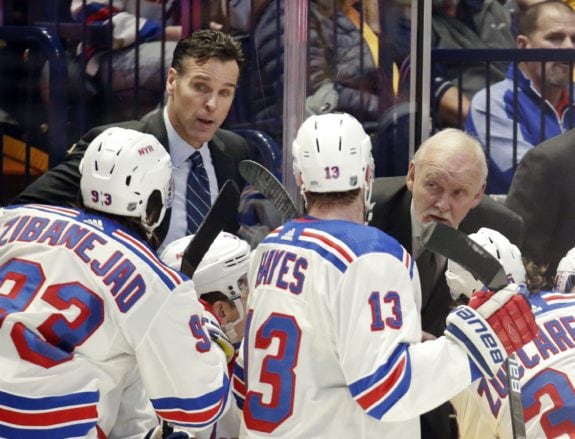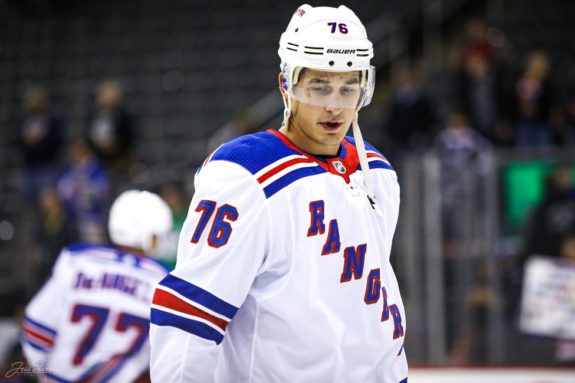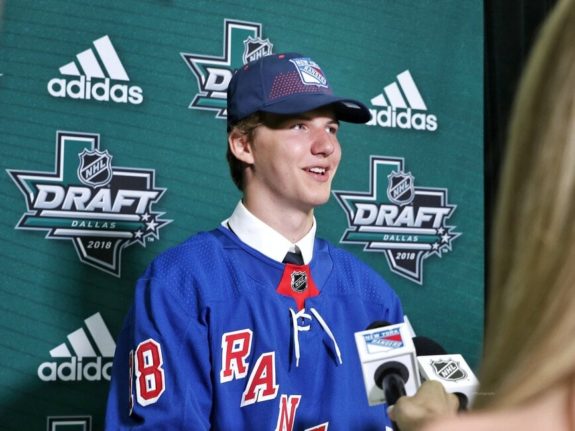By now, the scouting report on the New York Rangers is likely starting to become more detailed and consistent amongst their opponents. Though pure speculation, it might read something like this:
- Team struggles to handle speed and physicality, particularly when trying to defend and win pucks in the neutral zone.
- Defense especially has problems with both facets. Defenders don’t rise to the challenge physically when hit early and often, and forwards can easily get behind the defense for odd-man rushes and high-danger attempts.
- Despite having a number of talented players, team lacks identity and struggles to find consistency in its play as a result, with the roster lacking cohesion due to offseason turnover.
- Very young group suffering through NHL growing pains can be exploited by veteran teams.
The realities of the long road of rebuilding have set back in for the Rangers, now 2-4 after opening the season with consecutive victories. In retrospect, the scintillating opening-night 6-4 win over the Winnipeg Jets on Oct. 3 should have provided plenty of warning signs.

Pounded throughout by the big and physical Jets and giving up rush after rush to a club that raced up and down the ice and outshot them 47-32, the Blueshirts survived by getting timely goals and an outstanding performance in net from Henrik Lundqvist (sound familiar?) to come away with the unlikely and exciting victory.
Rangers’ Problems with Speed, Physicality Emerged
The Rangers handled the hapless Ottawa Senators in their next game, but the elements that gave them such trouble in their opener couldn’t be overcome after that. They looked overmatched in a 4-1 loss to the surprising Edmonton Oilers in the following contest, and the previously winless New Jersey Devils and then the Washington Capitals used their speed and physical play to outclass the Blueshirts in a pair of 5-2 victories that dropped the Rangers to 2-3.
They were mostly dominated again in a 3-2 loss to the Vancouver Canucks on Sunday, a game in which the Rangers were outshot 37-23 through two periods. Their strong third period doesn’t put to rest the ongoing issues that plagued them in the first 40 minutes.
“We ran around a little bit too much and just lost sight a little bit of our structure and our system, and they got their openings. We’ve got to play smarter,” center Mika Zibanejad said.
The defense, much maligned for its poor play for the past several seasons, hasn’t proven to be any better following the offseason makeover that saw the addition of Jacob Trouba from Winnipeg, the acquisition of highly regarded rookie Adam Fox and the elevation of Libor Hajek to a regular role. The unit doesn’t play with any sort of edge, Trouba is still trying to settle in and Brady Skjei is struggling for the third straight season, with coach David Quinn giving him four shifts and 3:43 of ice time in the second period Sunday.
“We’re looking for more out of him,” Quinn said of Skjei. “He’s got to play better. He’s got to be more consistent.”
Skjei, separated from Trouba after just one game as the much-hyped No. 1 defensive pairing fizzled in embarrassing fashion, looks lost at times. He’s hardly the only one, though. Right wing Pavel Buchnevich squandered his plum assignment on the top line with Zibanejad and Artemi Panarin and has been demoted down through the lineup. Chris Kreider has started the season with one of his characteristic disappearing acts, with the pending free agent yet to register a goal. Second overall draft pick Kaapo Kakko is feeling his way, hardly surprising for an 18-year-old trying to learn the ins and outs of playing in the NHL.

It probably isn’t a good thing that Ryan Strome and Brendan Smith, neither likely to play a major role in the team’s future, have drawn outsized praise for their strong play so far. They’ve stood out because so few of the team’s expected core players have.
“We have to pay attention to details and take care of our business one shift at a time,” Strome said after the Rangers fired 17 shots on net in the third against the Canucks. “We did that in the third period. That’s the template.”
Perspective, Patience the Keys for Rangers
Quinn is clearly aware of the irony of his team being susceptible to opponents that play the exact style he wants the Rangers to play. The coach doesn’t appear anywhere close to the “fast, physical and relentless” club he called for at his introductory press conference.
The Blueshirts possess top offensive talents in Zibanejad and Panarin, and Kakko might join them someday. They don’t, however, have the type of roster than will allow Quinn to fully demand the jagged, north-south style he covets, and watching the Jets, Devils and Capitals apply that approach so effectively against his Rangers can’t be fun.
Far too much was expected of this group going into the season. To a point, the excitement amongst fans was understandable. An 18-month rebuilding effort that yielded numerous high-end prospects including Kakko appeared closer to bearing fruit, especially when it was supplemented by the acquisitions of Panarin, Trouba and Fox.
What’s become painfully obvious instead is that the rebuilding process is always a slow one, regardless of talent level. Perhaps no player better symbolizes the overblown expectations than forward Vitali Kravtsov, the No. 9 overall pick in 2018 who’s seen as a future cornerstone but struggled during the preseason and has continued to do so at AHL Hartford. Kravtsov could trigger a clause that would allow him to return to the KHL and then rejoin the Rangers later in the season, which would leave him literally and figuratively a long way from his impressive performance in the Traverse City tournament last month.

What’s required here is adjusted perspective, not panic. The Rangers’ roster is loaded with talented kids who need time to find themselves in the best hockey league in the world. And the news isn’t all bad, with 20-year-old center Filip Chytil having performed well at Hartford after failing to make the team out of camp and likely to be called back up to the big club shortly.
The cases of Kravtsov and Chytil, a regular at the end of last season, should provide all the evidence needed to show that rebuilds (or “builds”) don’t trend endlessly upward. Instead, they’re bound to go sideways and backward and over plenty of bumps. The overly optimistic preseason predictions – including some truly absurd ones that included the words “Stanley Cup contender” – probably didn’t help, but Quinn’s mandate when hired was to manage these rocky times, all the while teaching and doling out tough love mixed with plenty of patience.
The question now is whether a characteristically impatient fan base – and local media – can put aside the inflated expectations and settle in for the longer haul that’s likely in front of the Rangers on their way back to consistent contention.